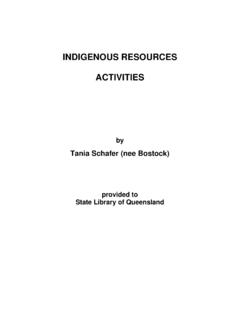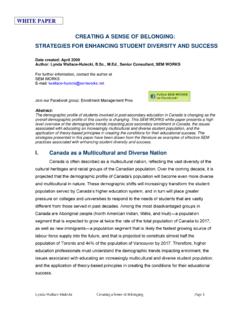Transcription of BELONGING, BEING & BECOMING
1 belonging , BEING &BECOMINGThe Early Years Learning Framework for AustraliaBELONGING, BEING &BECOMINGThe Early Years Learning Framework for AustraliaProduced by the Australian Government Department of Education, Employment and Workplace Relations for the Council of Australian Governments. Commonwealth of Australia 2009 ISBN 978-0-642-77873-4 This work is copyright. Apart from any use as permitted under the Copyright Act 1968, no part may be reproduced by any process without prior written permission from the Commonwealth. Requests and inquiries concerning reproduction and rights should be addressed to the Commonwealth Copyright Administration, Attorney-General s Department, Robert Garran Offices, National Circuit, Barton ACT 2600 or posted at , BEING & BECOMING The Early Years Learning Framework for Australia 3 CONTENTSINTRODuCTION 5 A VISION FOR ChILDREN S LEARNING 7 Elements of the Framework 9 Children s Learning 9 EARLY ChILDhOOD PEDAGOGY 11 PRINCIPLES 12 PRACTICE 14 LEARNING OuTCOMES FOR ChILDREN BIRTh TO 5 YEARS 19 Outcome 1.
2 Children have a strong sense of identity 20 Children feel safe, secure, and supported 21 Children develop their emerging autonomy, inter-dependence, resilience 22 and sense of agencyChildren develop knowledgeable and confident self identities 23 Children learn to interact in relation to others with care, empathy and respect 24 Outcome 2: Children are connected with and contribute to their world 25 Children develop a sense of belonging to groups and communities and 26 an understanding of the reciprocal rights and responsibilities necessary for active community participationChildren respond to diversity with respect 27 Children become aware of fairness 28 Children become socially responsible and show respect for the environment 29 Outcome 3.
3 Children have a strong sense of wellbeing 30 Children become strong in their social and emotional wellbeing 31 Children take increasing responsibility for their own health and physical wellbeing 32 Outcome 4: Children are confident and involved learners 33 Children develop dispositions for learning such as curiosity, cooperation, 34 confidence, creativity, commitment, enthusiasm, persistence, imagination and reflexivity Children develop a range of skills and processes such as problem solving, 35 inquiry, experimentation, hypothesising, researching and investigating Children transfer and adapt what they have learned from one context to another 36 Children resource their own learning through connecting with people, place, 37 technologies and natural and processed materials 4 belonging .
4 BEING & BECOMING The Early Years Learning Framework for AustraliaOutcome 5: Children are effective communicators 38 Children interact verbally and non-verbally with others for a range of purposes 40 Children engage with a range of texts and gain meaning from these texts 41 Children express ideas and make meaning using a range of media 42 Children begin to understand how symbols and pattern systems work 43 Children use information and communication technologies to access information, 44 investigate ideas and represent their thinking GLOSSARY OF TERMS 45 BIBLIOGRAPhY 47 belonging , BEING & BECOMING The Early Years Learning Framework for Australia 5 This is Australia s first national Early Years Learning Framework for early childhood educators.
5 The aim of this document is to extend and enrich children s learning from birth to five years and through the transition to school. The Council of Australian Governments has developed this Framework to assist educators to provide young children with opportunities to maximise their potential and develop a foundation for future success in learning. In this way, the Early Years Learning Framework (the Framework) will contribute to realising the Council of Australian Governments vision that: All children have the best start in life to create a better future for themselves and for the nation. 1 The Framework draws on conclusive international evidence that early childhood is a vital period in children s learning and development.
6 It has been developed with considerable input from the early childhood sector, early childhood academics and the Australian and State and Territory Governments. The Framework forms the foundation for ensuring that children in all early childhood education and care settings experience quality teaching and learning. It has a specific emphasis on play-based learning and recognises the importance of communication and language (including early literacy and numeracy) and social and emotional development. The Framework has been designed for use by early childhood educators working in partnership with families, children s first and most influential educators.
7 1 Learning Framework includes reference to Starting Strong II2 2008, The Apology to the Stolen Generation)Educators: early childhood practitioners who work directly with children in early childhood Investing in the Early Years - a National Early Childhood Development Strategy, Council of Australian Governments2 On 5 December 2008, State, Territory and Commonwealth Ministers of Education meeting as the Ministerial Council on Education, Employment, Training and Youth Affairs, released the Melbourne Declaration on Educational Goals for Young childhood educators guided by the Framework will reinforce in their daily practice the principles laid out in the united Nations Convention on the Rights of the Child (the Convention).
8 The Convention states that all children have the right to an education that lays a foundation for the rest of their lives, maximises their ability, and respects their family, cultural and other identities and languages. The Convention also recognises children s right to play and be active participants in all matters affecting their document may complement, supplement or replace individual State and Territory frameworks. The exact relationship will be determined by each jurisdiction. More broadly, the Framework supports Goal 2 of the Melbourne Declaration on Education Goals for Young Australians2, that: All young Australians become:Successful learners Confident and creative individuals Active and informed citizens.
9 INTRODuCTION6 belonging , BEING & BECOMING The Early Years Learning Framework for AustraliaThe Melbourne Declaration also commits to improved outcomes for Aboriginal and Torres Strait Islander young people and strengthening early childhood education. The Council of Australian Governments is committed to closing the gap in educational achievement between Indigenous and non-Indigenous Australians within a decade3. Early childhood education has a critical role to play in delivering this outcome. Children: refers to babies, toddlers and three to five year olds, unless otherwise stated. Recognising this, a specific document that provides educators with additional guidance on ensuring cultural security for Aboriginal and Torres Strait Islander children and their families will be developed and made available to time additional resources may be developed to support the application of this learning:a context for learning through which children organise and make sense of their social worlds, as they engage actively with people, objects and representations.
10 3 The Council of Australian Governments - Communique - 3 July 2008. Indigenous Reform - Closing the , BEING & BECOMING The Early Years Learning Framework for Australia 7A VISION FOR ChILDREN S LEARNINGBEINGC hildhood is a time to be, to seek and make meaning of the world. BEING recognises the significance of the here and now in children s lives. It is about the present and them knowing themselves, building and maintaining relationships with others, engaging with life s joys and complexities, and meeting challenges in everyday life. The early childhood years are not solely preparation for the future but also about the present.






